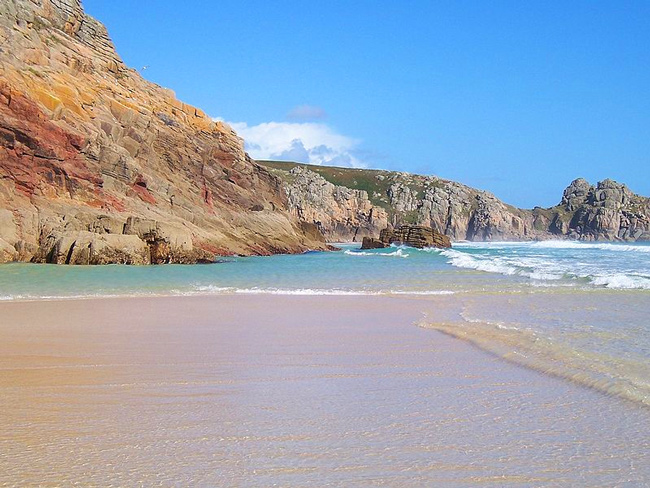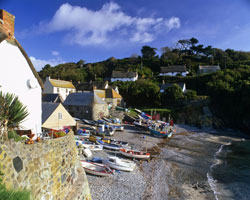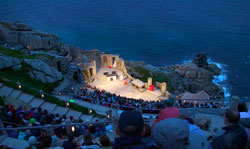From the literary romance of Daphne du Maurier country, to the seaside artists’ colony of St Ives, this south-west gem is a county of contrast.

Simply thinking of Cornwall – its very name is evocative, tinged with a sense of excitement and wildness – is enough to send me off into a dreamy reverie. There’s a vision swirling around in my head right now: I’m walking on a clifftop path, surrounded by a mass of heather, alight with a swathe of red and purple flowers. A gull is crying in the distance as it rides the thermals, backed by the muffled sound of surf rolling onto the rocks far below. A deeply blue Atlantic stretches out to an indistinct, hazy horizon, where it merges with a lighter, but equally blue, cloudless sky. There are no crowds, no traffic, no buildings, save a picturesquely tumbledown granite barn and an old mine wheelhouse. This is Cornwall at its most wonderful.

Inevitably, Cornwall is defined by its glorious coastline. A 100-mile-long peninsula, ringed by ocean on three sides, its history and culture have always been inextricably bound up with all things maritime, until relatively recently its isolation from the rest of Britain making it largely dependent on the sea for both communication and livelihood.
Mining, too, has been a part of Cornwall’s lifeblood, mostly tin, but other metals such as copper and lead, hammered out of the ground for much of the past 2,000 years. It led the region to be in the vanguard of the Industrial Revolution in the 18th and 19th centuries, when steam power came to run much of the mine machinery, creating one of Cornwall’s most enduring and iconic legacies – the skeletal remains of countless mine wheelhouses, surprisingly picturesque, marking the sites of hundreds of abandoned mines, and constituting one of the area’s most famous, quintessentially Cornish emblems.
Stories abound about Cornwall’s tin mines, though the most famous is fictional, created by writer Winston Graham, who grew up at Perranporth on Cornwall’s north coast. It is Poldark, a series of novels about a mine-owning family that was made into a famous television series in the 1970s, and which captivated audiences for several years.
Other writers are intimately associated with Cornwall, but for them the landscape was their inspiration. For years, Daphne du Maurier has been virtually synonymous with Cornish writing, having spent most of her life living close to the beautifully bucolic shores of the River Fowey. Most of her famous novels used locations in the area, including The House on the Strand, based on Kilmarth, her last home.
Writers are not the only artists inspired by Cornwall’s landscape and heritage. Painters, potters and sculptors have been making it their home since at least the 19th century, beginning with what is now called the Newlyn School of Painters, a group who established themselves in and around the fishing town of Newlyn in the 1880s. More recent is the St Ives School, developing in the 1950s in the nearby town of St Ives, and which in its heyday contained some of Britain’s most well known contemporary artists, including sculptress Barbara Hepworth and potter Bernard Leach.
Such was the influence of the St Ives School that in 1993 the Tate – one of Britain’s most prestigious art institutions – opened a gallery in St Ives to show off their work.
Theatre too, has its presence, most notably the stunning outdoor Minack Theatre, carved into the granite cliffs high above the sea at Porthcurno. To watch a play here, with nothing but the rolling sea as a backdrop to the performers, is an experience of a lifetime: after watching it here, Hamlet will never be quite the same again.
In terms of cultural sites and what might be called ‘living’ art, the wealth that Cornwall generated during its industrial and maritime heyday has left a rich legacy, particularly its stunning gardens. With its warm, almost frost-free and rather damp climate, Cornwall offered an ideal environment for the gardening Victorians. Fuelled in the late 19th and early 20th centuries by intrepid plant hunters, who delved deep into the world’s remotest corners in search of exotic plants, Cornwall developed what is now arguably Britain’s most stunning collection of gardens. Most are located close to the rather sheltered south coast, with a particular concentration in and around the verdant Helford and Fal river valleys close to the town of Falmouth, notably Glendurgan, Trelissick, Trebah and Trevarno. One of the most famous, however, is the intriguingly named Lost Gardens of Heligan, close to St Austell.
Heligan is perhaps one of Cornwall’s most visited gardens. It certainly is one of the most well known, if only for its name. Completely abandoned for 70 years, the garden was ‘rediscovered’ in 1990 and then restored, bringing back to life Heligan’s walled gardens complete with traditional greenhouses (where the gardeners have even managed to grow pineapples) and the dense lushness of the valley woodland, appropriately named the Jungle.
 |
| Minnack Theatre’s dramatic clifftop setting |
All these traditional gardens are dwarfed, however, by a thoroughly modern development that virtually overnight has become the region’s number one and most talked-about attraction: the Eden Project. Created just ten years ago in a disused china clay quarry near St Austell, Eden is a garden on a gargantuan scale, containing the world’s two largest conservatories, one of which incredibly is home to a tropical rainforest whose trees are able to reach their full 50 metre mature height. It is a homage to mankind’s dependence on the plant world, every plant here of importance to the human economy. It has been deliberately created in an area of Cornwall badly scarred by a declining quarrying industry, consciously aimed at promoting both global environmental concerns and the local economy.
Most of the historic gardens developed around wealthy homes, many of which are worthy of a visit in their own right, most especially Lanhydrock and Cotehele, both dating from the 16th century, the former a stunning mansion in wooded countryside near Bodmin, the latter built high above the River Tamar right on Cornwall’s eastern border. First prize for location, however, has to go to St Michael’s Mount, an island lying a short distance off the coast at Marazion, in Cornwall’s far west, and subject of the most quintessentially Cornish iconic view.
Yet, some of the most beguiling of Cornwall’s manmade structures belong to an era about which we have to guess and surmise. The landscape – particularly the far west around Penzance and St Ives – is littered with prehistoric ruins several thousand years old, a mysterious reminder of the ancient nature of this land. The partially excavated villages of Carn Euny and Chysauster are just the beginning – parts of these date from the Roman period, so are comparatively new. There are far older sites, such as Lanyon Quoit, the remains of an ancient burial chamber, and nearby Men-an-tol, a strange pair of standing stones separated by a pierced circular stone. Its significance remains a mystery, though locals used to believe that passing their children through the circular stone would protect them from rickets. Then there are various fortified hills, such as Chun Castle, and numerous stone circles, including the Merry Maidens, near St Buryan, so named because local folklore insists they were girls turned to stone for daring to dance on the Sabbath.
The sense of an ancient, long-settled land tied inextricably with a pre-Christian prehistory is heightened still further by the festivals, many of which clearly have pagan origins. Most famous of these is the Obby Oss, a festival unique to the north coast town of Padstow, held annually on 1 May. A spring fertility rite, it consists of two mythical ‘creatures’ draped in black being led around the town by a dancing, club-wielding ‘teaser’, followed by crowds of musicians.
A wholly historic festival is Tom Bowcock’s Eve, held in the superbly named Mousehole, a little fishing village near Penzance, annually on 23rd December. It celebrates the bravery of one Tom Bowcock, who rescued the village from starvation by bringing in a huge catch of fish. Essentially, the festival consists of the entire village eating ‘Star Gazy Pie’, containing the seven types of fish that brave Tom caught. ï
 |
| Try the local Cornish fish and chips |
Cornwall’s coast is punctuated by small heavily touristed towns, such as St Ives, Newquay and Padstow, the last of these the site of several of Britain’s most well-known restaurants, set up by celebrity chef Rick Stein. There is also the occasional fishing village, taking advantage of any protected cove, places like Boscastle and Port Isaac, gouged out of the granite cliffs. A few miles from Boscastle stands Tintagel, a small town made famous by the crumbling ruins of an ancient castle that teeters on the very brink of the Atlantic cliffs, birthplace – so stories insist – of the legendary King Arthur. You couldn’t hope to find a more atmospheric and dramatic starting point for such a charged legend.
As a general rule, the south coast, bordering the English channel, is calmer and more sheltered, site of a good many towns – including the ports of Falmouth and Newlyn and quaint fishing villages, such as Mousehole, the lovely little cove of Cadgwith and the much photographed Polperro.
Peppering the entire coastline is a necklace of stunning beaches, the main drawcard for many of Britain’s summer holidaymakers. The most famous stretch along the north coast, long miles of stunning, fine golden sand, such as Sennen, Hayle Towans, and the Newquay beaches, all meccas for Britain’s surfers, riding the Atlantic swell. At the most popular beaches anyone can have a go, with wetsuits and boards for hire, and tuition available.
It is always frustratingly difficult to put into words the beauty and excitement of Cornwall: there is just so much, and so much of it is unspoken, wordless whispers and atmosphere. Cornwall seeps into the bones and once there you’ll
find it very hard to leave, and even harder to stay away.
Cornwall Travel Information
For details of what to see and do, and where to stay, either telephone (01872) 322900 or visit www.visitcornwall.com.
Tourist Information Centres:
Truro: Municipal Buildings, Boscawen Street TR1 2NE. Tel: (01872) 274555; www.truro.gov.uk.
St Ives: The Guildhall, Street-an-Pol TR26 2DS. Tel: (01736) 796297; www.stives-cornwall.co.uk.
Padstow: Red Brick Building, North Quay PL28 8AF. Tel: (01841) 533449; www.padstow.com.
Newquay: Municipal Offices, Marcus Hill TR7 1BD. Tel: (01637) 854020; www.visitnewquay.org.





 © 2024
© 2024